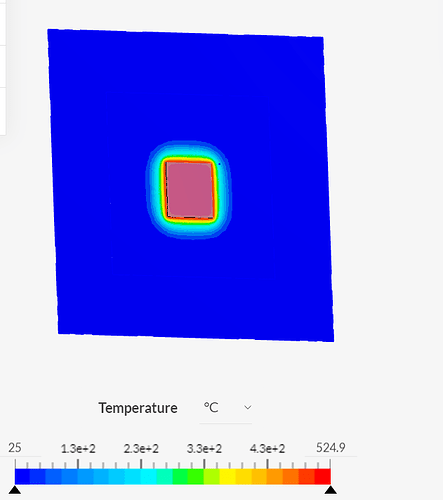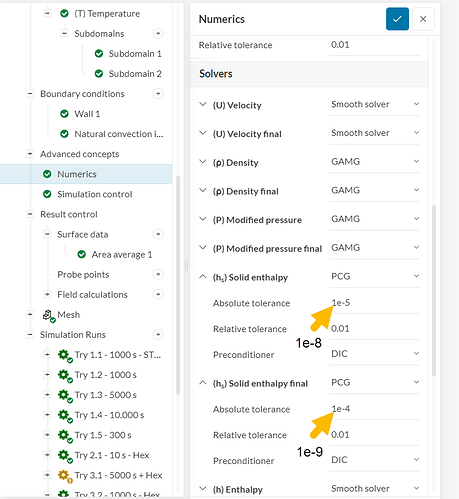Hi there,
I am just simulating a three cubes one inside another to emulate the heat transfer between an aluminium cast piece at 600ºC (nucleus, smallest cube) and the mould structure (second cube) and the aire (the biggest one that are an enclosure).
I don’t know why the heat transfer in my simulations (Run 1.2 - 1.5; 2.1 and 3.2) stops at any moment and it doesn’t expands throughout the structure of the mould and heat the air. As you can see, I’ve made simulations with different end times but it happens in every one.
I have selected Transient Conjugate Heat Transfer because the simulations works by fluid (air) and a solid (mould and the cast considering it has been solidified yet) and the boundary condition of the cast is a table that decreases the temperature from 600 to 250 ºC in 1000 s. I’ve created an initial conditions of a cartesian box for the smallest cube (cast) at 600 ºC and a velocity for the air at 1 m/s in Y axis.
I know that the boundary conditions have to be a Wall for the mould with a variable value in a table (like I’ve explained above), Natural convection for the biggest cube representing the air volume and I think I should have the Wall with a fixed heat flux boundary condition but if I set that a multiple boundary condition error appears.
What could be the problem?
LINK:
Thanks.
Sergi.
Hi Sergi,
I had a look at the project and noticed the behavior that you mentioned, where the temperature gets “stuck” and stops updating. The problem here is very simple: the solver tolerances are too loose, so the enthalpy scalar (which is then used to calculate the temperatures) is not being solved for.
Here is how it looks in the solver log:
To fix this, you’d need to change the absolute tolerance for the solid enthalpy solvers to much lower values (in order to ensure that they keep iterating). For instance:
Cheers
Thanks so much @Ricardopg.
I’ve changed those tolerances but some other issues happens. In some cases the simulations stops because a divergence in the system. I think this could be for the mesh is a little coarse. But I changed it for a finer one and another fact occurs: the simulation run involves a lot of hours. It’s so slow.
I’ve made a simulation for a 500s, and the heat is not transferred fully for all the geometry and the air enclosure. Now I am waiting for an end of a 1000s simulation that is about 5 hours running, although I think that heat won’t be transmitted fully with this time. Is it necessary to increase the End time for see all the heat spread for all the geometry? Could it be accelerated?
Finally, and advisement appears during the simulations saying the Courant number is so big but I think that thickening the mesh cause the divergence problem explained above and changing the time step slows down the simulations.
Thanks for your help.
Sergi.



